12 Real Property Law
Learning Objectives
- Explain the historical development of private property rights and their significance in the Canadian legal system.
- Define and differentiate between various interests in land, including: fee simple, life estate, leases, strata ownership, adverse possession, easements, and restrictive covenants.
- Identify and describe common land torts, such as trespass to land.
- Outline the typical process for purchasing and selling real property, including key legal considerations and documents involved.
- Compare and contrast different land titles systems, such as the Registry system and Torrens systems
Introduction
As we have already seen in previous chapters, the law protects a variety of different forms of property, including chattels (moveable property) and intellectual property. In this chapter though, we will be discussing the “realest” of all modern property – land and interests in land.
Real property law has evolved from its historical roots in English common law to a complex system which encompasses a myriad of forms of interests; it has also expanded on the rights of those who hold such interests. Throughout the chapter, we will explore the various interests one can have in real property, how such interests can be transferred and the systems that ultimately shape dispute and keep track of property transactions.
Historical Development of Real Property Law
To understand modern Canadian real property law, we must first look to its origins in Medieval England.
The Feudal System
The evolution begins with the Norman Conquest of 1066, led by William the Conqueror, which introduced the feudal system to England. Under the feudal system, all land ultimately belonged to the Crown (William as the King); however, the King had the power to divvy up interests in the land and grant them to others. William granted such interests to ensure greater protection over his lands – the idea was that citizens would have a deeper investment in the protection and productivity of the land if they also had a right to it.
During this feudal period, most land was held by “vassals” as “fiefs.” While these vassals – typically nobles and knights – had rights to the land, it was subject to various conditions and could revert back to the Crown under certain circumstances. The most frequent conditions were that the fief holder had to engage in military service and provide agricultural payments to the Crown.
The feudal system effectively created a pyramid-like structure of landholding, with the King at the top, followed by tenants-in-chief (usually the nobles), then sub-tenants (knights), and ultimately the peasants (serfs):
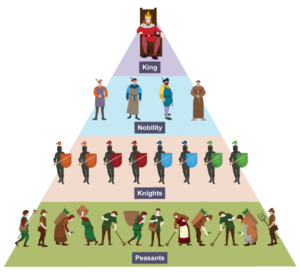
Fee Simple
The word “fee” comes from the feudal term “fief,” meaning land held in return for service, while “simple” indicates that the estate is free from limitations.
In modern property law, the fee simple represents the most complete ownership interest one can have in land, reminiscent of the broader control that lords had over their fiefs.
Statute of Quia Emptores
Another significant development in the evolution of property law came with the passage of the Statute of Quia Emptores in 1290. This statute, enacted during the reign of Edward I, prohibited subinfeudation – the practice of tenants granting portions of their land to others as sub-tenants. Instead, it allowed tenants to sell their lands freely, with the new owner becoming a direct tenant of the original lord. The most crucial element of this transfer was that the permission of the lord was not required.
The rights under the Statute of Quia Emptores meant that land could be transferred directly to another person. In effect, the feudal system was suddenly shifted from a system of personal loyalty to the noble/King to one that was more contractual. This ultimately laid the foundation for what would become modern conveyancing (transfers of real property interests).
Tenures Abolition Act 1660
The end of the feudal system and its appointment of land is most commonly associated with the Tenures Abolition Act of 1660 (also known as the Statute of Tenures or 12 Charles II, c.24).
By the 17th century, the dominant feudal system was in serious decline. This was mostly because the core military obligations of feudal tenants were no longer relevant as standing armies became established. Because the Crown had access to more highly trained and more permanent armies, it relied less on feudal obligations of military service.
Recognizing this new reality, King Charles II, sought to eliminate the feudal obligations. This was all done through the passage of the Tenures Abolition Act of 1660. According to the text of the Act, it converted most of the remaining feudal tenures from ownership based on military obligations into something called “socage” tenures which relied on obligations to provide rent or agricultural payments.
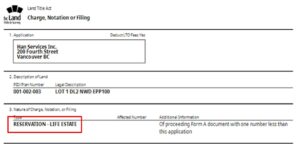
However, King Charles II also sought to secure compensation through the Act – of course the monarchy still wanted money from land.
As such, the Tenures Abolition Act also included new forms of taxation in which the tenure holder would have ongoing financial obligations to the Crown.
While the Crown received new compensation the net result of the Tenures Abolition Act was a reduction in the Crown’s direct control over land. It’s this reduction that allowed for the growth of private property rights.
Summary
The development of private property was gradual and occurred only when the Crown agreed to diminish its claim over the land. However, over time, there was a clear shift to a system whereby individual owners could transfer their interests in land to others without permission of the King; that entitlement remains the bedrock of our modern system of real property law.
Interests in Real Property
From our traditional beginnings in Medieval England, Canadian property law now permits a variety of forms of interests in land. These real property interests define the nature and extent of a person’s rights in relation to a particular piece of land. Below are some of the main forms of Canadian property interests.
Fee Simple
We previously saw that the feudal system resulted in the establishment of the fee simple. The fee simple grants the owner full rights to the property, including the authority to use the land, develop it, or alter it as they choose. To this day, the fee simple remains the most comprehensive form of property ownership in Canada.
The bundle of rights within the fee simple also extends to the right to sell, lease, or otherwise transfer the property, either permanently or temporarily, to another party. Even more stark is the ability of the fee simple holder to dispose of the property after death through will or inheritance, allowing the property to be passed down to heirs.
Effectively, fee simples are perpetual in nature; it does not have a predetermined end date. Unlike other forms of tenure or interests that may revert back to someone or expire after a certain period, a fee simple continues indefinitely. This means that the ownership can be maintained across generations, without any requirement to renew or re-establish the interest.
For example, imagine an individual, Sunmi, purchases a house in Vancouver. If she holds it in fee simple, she has the right to live in it, rent it out, renovate it, or even demolish it (subject to bylaw regulations in Vancouver). Sunmi can also sell the property whenever she chooses or leave it to her children in her will. This type of control over the land is what makes the fee simple so desirable.
In some very rare cases, a fee simple interest may be lost. This typically occurs when the holder of the fee simple dies without heirs and otherwise has not designated a beneficiary of the property in their will. If there are no heirs (as defined by the law) and no beneficiary under a will, then where does the property go? The answer is a concept called escheat which states that the property ownership reverts back to the Crown as the ultimate owner of land. Therefore, in our above example with Sunmi, if she died without a will and without any heirs, the Province of British Columbia would become the owner of her land.
The fee simple is noted on the land title documents showing the owner of the property:
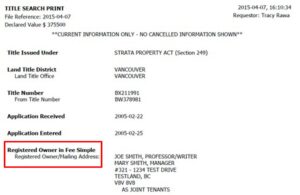
Joint Tenancy and Tenancy-in-Common
If we examine the above land title documents again, we can see that there is actually not one fee simple owner, there are two:

It is very common for there to be multiple owners of a fee simple; however, how that ownership is structured can be different. For various reasons, parties may choose to be listed as joint tenants while others may wish to be tenants-in-common.
I. Joint Tenancy
Joint tenancy is a form of co-ownership where two or more individuals hold equal shares in a property. For example, if two people hold the fee simple as joint tenants, they would each be entitled to a 50% share of the property. There is no limit on the number of joint tenants that can hold one property – if there were four joint tenants, then each would have a 25% share in the land.
As the joint tenants hold identical shares, if the property were to be sold, they would be entitled to equal profits (assuming there was no other contractual agreement altering that presumption). Accordingly, if the two joint tenants sell the property for $1,000,000, they would each receive $500,000.
Without a doubt, the defining aspect of joint tenancy is the right of survivorship. The right of survivorship means that when one joint tenant dies, their share of the property automatically passes to the surviving joint tenants rather than being distributed according to the deceased’s will or the rules of intestacy (dying without a will).
One of the clear advantages of having property pass through survivorship is that it helps sidestep the probate process – the legal process through which a deceased person’s will is validated and their assets are distributed. One of the byproducts of probate are “probate fees”, which are calculated on the assets in the estate. Accordingly, survivorship allows joint owners to pass the property to the remaining survivor without it being counted in the probate process.
For example, imagine three individuals own a property as joint tenants and one dies. The remaining two owners automatically inherit the deceased’s share, continuing to hold the property as joint tenants with equal shares. If one of the other joint tenants passes away, then the last surviving joint tenant will hold the property in its entirety. At each stage, probate was avoided.
In our land title documents, we see that Joe and Mary Smith have elected to be “joint tenants” to access those advantages.

II. Tenancy-in-Common
Tenancy-in-common, on the other hand, allows two or more individuals to own property together but with unequal interests and without the right of survivorship.
Under a tenancy-in-common, each owner has a specific share of the property, which can be equal or unequal, depending on the contributions or agreement among the co-owners. For instance, one tenant might own a 60% interest in the property, while another owns 40%. If the property were to be sold, the owners would take their share of the profits in accordance with their share of the ownership. Assuming a $1,000,000 sale of the property, the 60% holder would receive $600,000, and the 40% holder would receive $400,000.
Unlike joint tenancy, if a tenant in common dies, their share does not automatically pass to the surviving co-owners. Instead, it becomes part of the deceased’s estate and can be inherited by heirs or transferred according to their will. Without the automatic survivorship rights, co-owners have the flexibility to leave their share of the property to someone other than the other co-owners.
Example – Joint Tenants versus Tenants-in-Common
Jaspreet and Michael are considering pooling their money and purchasing a fee simple interest in a Vancouver townhome. They must decide whether to hold the property as joint tenants or as tenants in common – each option has different implications for ownership, inheritance, and the division of profits if the property is sold.
If Jaspreet and Michael choose joint tenancy, they will each own an equal share of the townhome, and their ownership will include the right of survivorship. This means that if either Jaspreet or Michael passes away, the deceased’s share of the townhome will automatically transfer to the surviving co-owner. If Michael were to pass away, Jaspreet would become the sole owner of the townhome, regardless of any provisions in Michael’s will. The property would not form part of Michael’s estate, and his heirs would not inherit any interest in the townhome. If the property is sold while both are alive, they would typically split the profits equally.
On the other hand, if Jaspreet and Michael opt for tenancy in common, they can each own a specific percentage of the townhome, which does not have to be equal. They could agree that Jaspreet owns 60% of the property while Michael owns 40%, reflecting their individual contributions to the purchase. In this arrangement, there is no right of survivorship. If Michael were to pass away, his 40% share would not automatically go to Jaspreet; instead, it would become part of his estate and be distributed according to his will. Michael’s heirs could inherit his share of the townhome and potentially become co-owners with Jaspreet. If they later decide to sell the townhome, the profits would be divided according to their ownership percentages, meaning Jaspreet would receive 60% of the proceeds and Michael’s estate would receive 40%.
Life Estate
A life estate is a more limited form of property ownership compared to the fee simple. A life estate grants the right to use and occupy property for the duration of a person’s life (or the life of another person). Upon the death of the life tenant, the property reverts to the fee simple owner or their designated beneficiary.
The main difference between a fee simple and a life estate is that the fee simple owner can dispose of the land – either during the owner’s lifetime or upon their death. A life estate is much more limited, as it does not grant similar disposition rights despite the fact that it provides exclusive possession.
Life estates are less common but can be useful in certain situations, as seen in the following example.
Example – Life Estate
John owns a fee simple interest in a cottage that he only infrequently uses. Mai, John’s sister, has recently found herself without a place to live. John, wanting to help, grants his sister a life estate in his cottage.
The life estate allows Mai to use the cottage for her lifetime, providing her with secure housing. However, upon Mai’s death, the property would revert back to John as the fee simple owner or pass to whomever John designates (his spouse, children, or another designated beneficiary). The life estate allows John to provide for his sister while ensuring the property ultimately passes to his chosen heirs.
As with the fee simple, the life estate interest will also be noted on the land title documents:

Leasehold
A leasehold interest grants the right to exclusive possession of property for a specified period. Leaseholds are very common interests and are held by tenants in rental properties (residential or commercial).
As with life estate interests, the holder of a leasehold gets exclusive possession; however, it is limited by a set duration. Leasehold interests can vary greatly in duration and terms. A residential tenant might have a one-year lease while a commercial tenant could have a 10-year lease with options for renewal. Once the term of the lease expires, possession of the property reverts to the fee simple owner.
For example, if a person rents an apartment for a one-year term, they have a leasehold interest in that property for the duration of the lease. During this period, the tenant has the right to exclusive possession and use of the property (subject to the terms and conditions outlined in the lease). The tenant also has obligations under the lease, such as paying rent, not damaging the property, and complying with other legal rules.
One of the unique features of leaseholds is the heavy degree to which they are regulated by various levels of government. In British Columbia, there are statutory obligations for both landlords and tenants, as specified in the Residential Tenancy Act, SBC 2002, Chapter 78.
Strata Ownership (British Columbia)
One of the hottest real estate markets involves “condos” or “stratas.” This is a type of shared ownership structure that involves a mix of fee simple and co-ownership. The language can sometimes be confusing because, while we are typically speaking about multi-unit buildings, such units are referred to differently depending on which part of Canada you are in. In British Columbia, it is called strata ownership, while in other provinces, it is referred to as condominium ownership.
In a strata property, individuals own their units in a larger area while sharing ownership of common property. Consider the following strata area:
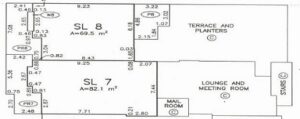
“SL 7” and “SL 8” represent specific strata lots within the property – these are individual units owned separately by different owners under fee simple ownership. The owners of SL 7 and SL 8 therefore have full control over their specific units and can sell, lease, or transfer them as they wish (subject to any restrictions imposed by the strata corporation).
In addition to owning their respective strata lots, the owners of SL 7 and SL 8 also have a shared ownership interest in the common property of the building. In the image, the common property would include the “Terrace and Planters,” “Lounge and Meeting Room,” and “Stairs.” These areas are co-owned by all the individual unit owners, and they share the responsibility for maintaining and managing these spaces through a strata corporation (called something different in other provinces).
Ultimately, stratas are dual ownership structures. While the owners of SL 7 and SL 8 have fee simple ownership of their individual units, they also participate in the co-ownership of the common property, which involves the upkeep of shared spaces.
To resolve some of the disputes that can arise between strata owners, the Province of British Columbia has passed the Strata Property Act, SBC 1998, c. 43. The Act governs strata properties in British Columbia and provides a framework for the creation, operation, and management of strata developments.
Easements
An easement is a right to use another person’s land for a specific purpose. Easements are interesting as they are referred to as a non-possessory interest, meaning the easement holder does not own or possess the land but has certain rights over it.
The most common type of easement is a right-of-way, which allows someone to pass through someone else’s property to access their own, especially in cases where direct access to a public road is not available. In some cases, this right-of-way could be sought by a utilities company (electrical, sewer, water) needing access to a certain area.
Easements involve two key types of land: the servient tenement and the dominant tenement. The servient tenement is the parcel of land that is burdened by the easement, meaning it is the land over which the easement runs and where the specific rights are exercised. On the other hand, the dominant tenement is the land that benefits from the easement, gaining certain rights, such as access or utility use, over the servient tenement.
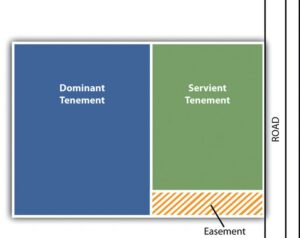
Easements can be granted in several ways. They may be created through a formal agreement between property owners outlining the scope of the grant of easement. Additionally, easements can be imposed by law or court order particularly, in cases where access or utility services are essential for the reasonable use of a property. Once established, easements are generally permanent and bind future owners of the land.
Legal Test for Creation of an Easement
Generally, for a valid easement to be created, it must meet the following criteria:
- there must be a dominant and servient tenement;
- the easement must accommodate the dominant tenement;
- dominant and servient tenements must be different people; and
- the right must be capable of forming the subject matter of a grant.
Kaminskas v. Storm, 2009 ONCA 318 at para. 27
Lastly, it is common for easements to be formally documented and registered with the various land title registries (in British Columbia it is the Land Title & Survey Authority). The easement will be noted as a legal notation or charge on the title, signifying that the easement has been granted.
Foundational Law – Ellenborough Park, Re [1956] Ch 131
One of the principal English cases dealing with easements is Ellenborough Park, Re [1956] Ch 131. The case concerned a piece of land, Ellenborough Park, which was a large private garden in Weston-super-Mare. Surrounding the park were several houses and the owners of these houses had rights to use the park for recreational purposes, as granted by the original property deeds. However, a dispute arose about whether this right to use the park constituted a valid easement under English law.
The Court of Appeal ruled that the right to use the park did indeed constitute an easement. The court’s decision hinged on the typical characteristics for an easement:
- is there the existence of a dominant tenement
- does the easement accommodate or benefit the dominant tenement;
- are the dominant and servient owners different persons; and
- right claimed must be capable of forming the subject matter of a grant.
In applying these criteria to the case, the Court found that the houses served as dominant tenements while the park was the servient tenement. Also, the right to use the park provided a clear benefit to the homeowners who were able to access it as they so chose. The ownership of the homeowners and the park were appropriately distinct. And finally, the right to use the park was indeed grantable.
As such, there was a valid easement taken over the park area.
Restrictive Covenants
Another form of non-possessory interest is called a restrictive covenant. A restrictive covenant is an agreement that limits the use of land. Unlike easements, which result in an easing of the enforcement of property rights, restrictive covenants do the opposite – they restrict some rights that would otherwise be held by the fee simple owner.
Restrictive covenants allow property owners, developers, or communities to exercise a degree of control over how land is used; this is true even after the land has been sold. In effect, restrictive covenants are a private form of land-use regulation, imposing certain restrictions on what can be done to the land. For example, restrictive covenants could be used for environmental protection, prohibiting the removal of certain trees or preserving designated green spaces. In historical districts, covenants can help preserve the architectural integrity of buildings by limiting changes to the building.
What makes restrictive covenants particularly “restrictive” is that they run with the land, meaning they bind not only the original parties but also subsequent owners of the property. Accordingly, if an individual buys a property subject to a restrictive covenant, they are bound by its restrictions whether they like it or not. For example, the following is a restrictive covenant registered against a West Vancouver, BC property:
![]()
Based on the restrictive covenant, no buyer of this property could ever keep poultry, swine, etc., as they would be in breach of the covenant registered against title. Buyers always have to be careful to understand if the property they are purchasing are bound by any such restrictive covenants.
While restrictive covenants can be beneficial in maintaining specific property elements or uses, they can also be controversial. In the past, restrictive covenants have been used to discriminate against certain groups from buying specific properties. Again, we can turn to the West Vancouver, BC property title that restricted poultry and swine – if we read further in the covenant, we can see another restriction in section 7:

This racist restrictive covenant was applied to the property to prevent certain ethnicities from owning the property.
Over time, courts generally sought to undermine the enforceability of discriminatory covenants, including in the Supreme Court of Canada case Noble v. Alley; however, legislation has ensured that any such covenants are void. In British Columbia, section 222 of the Land Title Act, [RSBC 1996] CHAPTER 250 specifies that covenants that restrict the sale, ownership, occupation, or use of land on account of sex, race, creed, colour, nationality, ancestry, or place of origin of a person are void and of no effect. Therefore, discriminatory covenants are not enforceable.
Foundational Law – Noble v. Alley [1951] SCR 64
The case arose when Annie Noble, a property owner, sought to sell her land to Bernard Wolf. However, the restrictive covenant on the property stated the following;

Noble and Wolf challenged the validity of this covenant, arguing that it was contrary to public policy and unenforceable.
The Supreme Court of Canada ruled in favour of Noble and Wolf, declaring the restrictive covenant unenforceable. However, the Court’s reasoning was not primarily based on the discriminatory nature of the covenant. Instead, the majority opinion focused on the technical legal grounds that the covenant was too vague and uncertain to be enforced. The Court reasoned that terms like “Jewish” or “Hebrew” were not sufficiently precise in legal terms, as they could refer to religious, cultural, or ethnic identities, making the covenant’s application ambiguous.
The decision did effectively strike down the racist covenant; however, the broader issue of whether such discriminatory covenants were fundamentally against public policy remained unresolved. This dodge has resulted in legal criticism of the case, with many arguing that the Court missed an opportunity to make a stronger statement against racial discrimination in property law.
Interests Acquired from Legally Taking the Land
We would typically imagine that acquiring a fee simple in land requires a buyer to pay for it or that ownership was granted by the fee simple owner upon their death. However, there are rare cases in which property interests can be taken or acquired in law. The principal means by which this can happen are adverse possession and expropriation.
Adverse Possession
Can someone who squats on property ever become the owner? As with many legal questions, the answer is: it depends.
Adverse possession is a legal doctrine that allows a person who is not the legal owner of a property to acquire title to that property by occupying it for a specified period of time and that the possession is adverse to the interests of the actual owner. The principle is that land should be used productively and that long-term neglect by the legal owner should result in a loss of title.
Despite some controversies, adverse possession has had an incredibly long and robust history. It played a significant role in the settlement and development of Canadian territories during the 18th and 19th centuries. In the early stages of Canadian settlement, many areas lacked formal land registration systems. Settlers would often claim land by simply occupying it and improving it through farming, building homes or wells, or other forms of development. If they maintained this occupation for enough time (typically 20 years, though it varied by province), they could potentially claim legal ownership through adverse possession.
The argument for adverse possession in settler cases had some pragmatic appeal. Rural and frontier areas had no proper formal surveying, and land registration was incomplete or non-existent. Settlers might inadvertently occupy land beyond their official boundaries or even intentionally expand their holdings into adjacent unclaimed areas. Over time, if these actions went unchallenged by the true owner (likely the Crown), the settlers could argue that they had become the rightful owners.
In the modern context, adverse possession raises more delicate debates. Should the original owner of a house have to do anything at all on their property to keep ownership? Should someone who openly violates the property interest of another be permitted to evolve from a trespasser to become the fee simple owner? Should this still be allowed when Canadian property is so expensive?
Today, the law of adverse possession falls into two legal worlds: 1) the common law, and 2) provincial statutory rules.
I. Common Law
Under the common law, it is possible to obtain ownership through adverse possession. Generally, the test requires actual possession of land for a prescribed period of time – typically between 10 and 20 years. The possession must be open and adverse to the owner’s authority (generally, without the owner’s permission).
Legal Test for Adverse Possession
In order to establish adverse possession, all of the following elements are required:
- actual possession for the statutory period (typically between 10-20 years);
- such possession was with the intention of excluding from possession the owner or persons entitled to possession; and
- discontinuance of possession by the owner for the statutory period.
Teis v. Ancaster (Town) (1997), 1997 CanLII 1688 (ON CA)
citing Pflug v. Collins, 1951 CanLII 80 (ON SC)
To lawfully obtain a fee simple interest through adverse possession (where it is still possible), the adverse possessor would need to demonstrate that their possession met all the required elements consistently throughout the statutory period. An example where common law adverse possession might have applied would be a squatter occupying an abandoned rural property and treating it as their own for the required time. Another good example would be where a neighbour unknowingly builds a structure (shed/garage) that encroaches on adjacent land and uses it undisturbed for the statutory period:

II. Provincial Statutory Rules
Provincially, adverse possession has been largely eliminated due to legislative changes. As real estate has become more valuable, provinces have enacted specific rules heavily restricting adverse possession claims or eliminating it altogether.
In British Columbia, adverse possession has been effectively eliminated due to the enactment of the Limitation Act. Section 28 of the Act explicitly states the following:
28(1) Except as specifically provided by this or any other Act, no right or title in or to land may be acquired by adverse possession.
28(2) Nothing in this Act interferes with any right or title to land acquired by adverse possession before July 1, 1975.
As written, adverse possession claims are abolished with the only exception being occupations of land prior to July 1, 1975. Given the new wording, it will be extraordinarily rare to see modern claims for adverse possession in BC.
Foundational Law – Teis v. Ancaster (Town), 1997 CanLII 1688 (ON CA)
Teis v. Ancaster (Town) involved a dispute over a strip of land between the Teis family’s property and a public road owned by the Town of Ancaster. The Teis family had been using this strip of land for over 40 years, maintaining it as part of their front yard. They claimed ownership through adverse possession when the town attempted to assert its rights over the property.
At trial, the Teis family was granted adverse possession of the strip; however, the trial judge also ordered that the public was entitled to travel over part of the laneway on foot.
The Court of Appeal emphasized that for adverse possession, there must be actual possession of land and an intention to exclude the true owner for the statutory period, which in Ontario was ten years. The court clarified that the intention to exclude the true owner does not require hostility or antagonism, but rather an intention to use the land as one’s own.
Ultimately, the Court of Appeal found that the family had indeed established adverse possession and upheld their claim over the strip. Their long-term use and maintenance of the land, coupled with their belief that it was part of their property, satisfied the common law test. The court also upheld the public right-of-way to travel by foot.
Expropriation
The second situation where land may be transferred without the consent of the fee simple owner is expropriation. Expropriation is the act of a government or authority taking private property for public use or benefit. In some jurisdictions, including the United States, expropriation is also known as eminent domain, though its features are the same – the allowance of governments to acquire land or property rights for projects deemed to be in the public interest. While the land may be taken by the public authority, in Canada, the original owner is entitled to compensation for the land.
Under British Columbia law, various public authorities, including provincial ministries, municipalities, and Crown corporations, have the power to expropriate property. Examples include large infrastructure projects where there would be tremendous benefit to the public. Think of governments needing to acquire land for highway expansion, constructing public buildings like schools or hospitals, or developing utility infrastructure such as power lines or water treatment facilities. In such cases, the compelling public interest outweighs the private property interest of the owner.
To lawfully expropriate property in BC, the expropriating authority must follow specific steps outlined in the Expropriation Act [RSBC 1996] CHAPTER 125. These typically involve providing notice to the property owner, conducting surveys and appraisals, negotiating in good faith, and, if necessary, proceeding with a formal expropriation process through the courts.
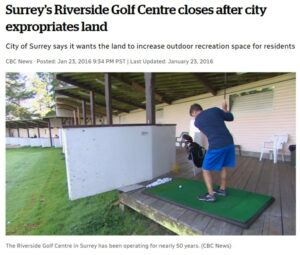
Despite having the power to expropriate, governments must still comply with the requirements established by the Expropriation Act.
According to the Act, there are numerous considerations to ensure that the expropriation is lawful and fair. First, the expropriating authority must have the legal power to expropriate – not all organizations are empowered to expropriate though governments certainly are. There must also be a determination of whether the expropriation is necessary for a public purpose or in the public interest.
The authority is required to make reasonable efforts to acquire the land by agreement with the owner before resorting to expropriation. If these negotiations fail, the authority must serve a notice of expropriation on the owner and file it with the Land Title Office. The owner then has the right to request an inquiry to determine if the expropriation is necessary and in the public interest. If the expropriation proceeds, the authority generally provides an advance payment based on its estimate of market value and serves a notice of possession.
Throughout this expropriation process, the owner has the right to object, to be heard at an inquiry, and to claim compensation.
Above and Below the Land
An interest in land includes, first and foremost, the soil and physical land of the property. However, interests in land involve more than just the surface area of a given parcel. Real property interests also extend vertically both above and below the earth’s surface, as well as to various attachments to the land itself. In the following, we will canvass those extended rights held by the interest holder.
Fixtures
Fixtures are personal property (chattels) that have been attached to the property in such a way that they become part of the land. This can include buildings, permanent structures, and even certain types of equipment or machinery that are seriously integrated into the property.
The distinction between chattels and fixtures is important because it affects what is included in the sale or transfer of property. When real property is sold, fixtures are typically included in the sale unless explicitly excluded in the contract while chattels remain the personal property of the seller unless specifically included.
Generally, whether an item is a fixture or chattel comes down to determining the degree and purpose of the attachment of the item. More specifically, the BC Court of Appeal has highlighted key principles for determining whether an item is affixed to the land in Scott v. Filipovic:
Legal Test for Determining a Fixture versus Chattel
Determining whether an item is a fixture or chattel involves the following core principles:
- Articles not otherwise attached to the land than by their own weight are not to be considered as part of the land unless the circumstances show that they were intended to be part of the land.
- Articles affixed to the land even slightly are to be considered part of the land unless the circumstances show that they were intended to remain chattels.
- A different intent is determined objectively by facts “patent to all to see,” such as the degree and purpose of attachment to the land.
- Fixtures installed by a tenant are still fixtures, although the landlord may agree to sever them and return them to the tenant as chattels.
Scott v. Filipovic, 2015 BCCA 409 (CanLII)
In commercial contexts, the treatment of fixtures can be particularly complex. Tenants often install significant equipment or improvements, and the lease agreement should specify whether these become fixtures (and thus property of the landlord) or remain the tenant’s property to be removed at the end of the lease.
Airspace and Subsurface
An interesting legal maxim is “cuius est solum, eius est usque ad coelum et ad inferos,” which means “whoever owns the soil owns up to the heavens and down to the depths.” The notion is that ownership rights are expansive and include more than just the soil. While true as a starting point, modern law has placed some limitations on its literal interpretation.
Air rights are the rights to the space above the land surface. The extent of airspace rights is often described as the area that can be reasonably used and enjoyed in connection with the land. This might include, for example, the space needed for buildings or trees. However, airspace rights do not extend to the point of interfering with air traffic. While limited, air rights can be incredibly lucrative, especially in city settings, where the airspace above existing structures can be bought, sold, or leased to preserve views.

Subsurface rights extend below the earth’s surface and can include ownership of minerals, oil, gas, and other resources found beneath the property. However, the law generally presumes that an owner’s subsurface rights extend only to a depth necessary for the ordinary and “reasonable” use and enjoyment of the land.
If a neighbouring landowner or another party were to encroach on the subsurface of the fee simple owner’s property, the fee simple owner might have a claim for trespass provided the depth of the intrusion is within a reasonable use of the land. For instance, unauthorized drilling under someone’s land could be considered trespass if it interferes with the owner’s subsurface rights.
Certain subsurface rights may be subject to Crown reservations. This means that even though a person may own the land in fee simple, the minerals beneath the surface may be owned by the provincial or federal government. In such cases, the fee simple owner does not have the right to exploit these resources without obtaining a lease or permit from the government.
Trespass to Land
Trespass to land is a tort (civil wrong) that occurs when someone enters another’s property without permission. It’s one of the primary legal protections for property owners’ right to exclusive possession of their land.
Trespass can include physical entry onto the land, placing objects on the land, or causing harm to the land. For example, if a neighbour builds a fence that encroaches on another person’s property, this could constitute trespass to land. The property owner may seek legal remedies, including damages or an injunction to remove the encroaching structure.
Exercises
For a claim of trespass to land to be successful, there must be:
- 1) entry onto another’s property; and
- 2) without authority.
Veness v. Kamloops et al, 2000 BCSC 1042 (CanLII) at para. 27.
Unlike some tort claims, trespass is actionable “per se,” meaning that the property owner does not need to prove any actual damage to succeed in a trespass claim – the mere fact of unauthorized entry is sufficient.
Foundational Law – Kranz v. Shidfar, 2011 BCSC 686 (CanLII)
In Kranz v. Shidfar, 2011 BCSC 686, the plaintiffs, Frederick and Katarina Kranz, owned a property adjacent to the defendant, Mohammad Shidfar, in West Vancouver, BC. The dispute arose when Shidfar directed his worker to cut down trees near the boundary between the two properties as part of renovations on his land. Unfortunately, several trees on the Kranzs’ property were mistakenly felled. The Kranzs sued for trespass, claiming damages for the unauthorized removal of their trees.
The Supreme Court of BC held that Shidfar was liable for trespass, emphasizing our previous point that trespass is actionable without proof of damage. Shidfar admitted that his worker, under his direction, mistakenly cut down the trees on the Kranzs’ property.
Justice Groves awarded the plaintiffs $42,000 for the cost of restoring the trees, $20,000 for loss of enjoyment of their land due to the loss of privacy, and $35,000 in punitive damages. The punitive damages were particularly justified by Shidfar’s recklessness in failing to ascertain the true property boundary before instructing the tree removal, as well as by the fact that he cut down a final tree after being expressly asked not to by the Kranzs. The total damages awarded to the plaintiffs amounted to $97,000.
Property Transactions in British Columbia
While it is beyond the scope of this chapter to lay out every step in a real estate transaction, it is worth noting some of the major requirements in land transactions. The following discussion briefly outlines a few key factors in the purchase of real property in British Columbia.
Contract of Purchase and Sale
British Columbia land transactions will involve a Contract of Purchase and Sale (“CPS”), which is also referred to as an “Agreement of Purchase and Sale” or “Purchase Agreement.” The CPS is typically a standardized contract that outlines the terms and conditions of the property sale.
The starting point for the CPS is the identification of the buyer and seller and a description of the property subject to the transaction:
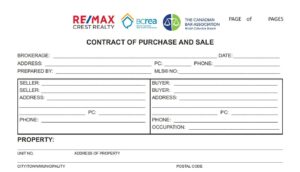
Within the CPS there will also be a variety of other terms including the following:
I. the purchase price
The CPS describes the purchase price for the property:
![]()
II. deposit amount
The CPS identifies whether the buyer has paid a deposit to secure the purchase of the property and, more importantly, what is to happen to the deposit if the buyer or seller backs out of the transaction:
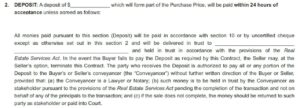
III. Subjects or Conditions on the Sale
Even if the offer is accepted, the CPS will likely contain conditions that must be satisfied before the contract is fully enforceable (these are referred to as conditions precedent or “subjects”). Typical subjects that must be met include the buyer obtaining financing or a satisfactory home inspection. In effect, the subjects allow the buyer to back out of the deal if certain criteria are not met; however, once the conditions are successfully removed, the contract becomes binding.

IV. completion date
On the completion date or closing date, the transfer of title is registered at the Land Title Office and the funds are transferred to the seller.
![]()
V. possession date
The possession date identifies when the buyer takes possession of the property and can move in or begin using it. The possession date also marks the transfer of responsibilities such as taxes, utilities, and insurance over the property.

VI. Included items
In the CPS, the parties should clearly indicate what is included in the sale. For example, the buyer and seller will want to ensure that they have described whether appliances run with the sale or any other specific items. As noted previously, fixtures are presumed to run with the land unless some contrary intention is stated by the parties.

VII. Expiry of the Offer
Both buyers and sellers want there to be specificity on how long an offer remains open for acceptance. As such, the CPS will contain a specific deadline by which the seller must accept the buyer’s offer. If the seller does not accept the offer by this date and time, the offer automatically expires (meaning it is no longer binding on the buyer) and the buyer is not obligated to proceed with the purchase.

VIII. Summary
For the most part, the CPS is a standard form; however, parties will obviously want many customizations. As contracting parties, the buyer and seller can make whatever changes they wish to the terms by modifying the CPS language or attaching addenda to the agreement.
Once submitted by the buyer, the seller reviews the CPS and may choose to accept, reject, or counter the offer. The negotiation phase can involve multiple rounds of offers and counter-offers until both parties reach an agreement or decide to walk away. If the seller accepts the offer, the buyer then has a period to satisfy or remove any of the listed conditions/subjects such as securing financing or completing a satisfactory home inspection.
The CPS is a legally binding document once accepted and all the conditions are removed. If one of the parties then has remorse about the deal or wants to walk away, they could be sued for breaching the terms of the agreement. Assuming a breach, any penalties listed in the agreement could be enforced by the court (such as the loss of the deposit).
Land Title Forms
Where the CPS leads to a successful sale, the parties will also execute a transfer of the legal title of the property and register it with the Land Title & Survey Authority.
In British Columbia, the key transfer form is called Form A. The execution of the Form A (Freehold Transfer) will formally transfer ownership of land from the transferor to the transferee.
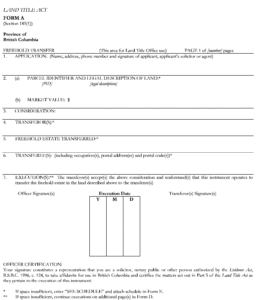
To effectively transfer the property interest, Form A must be registered with the BC Land Title & Survey Authority (LTSA).
Land Title Systems
So far in this chapter, we have discussed numerous forms of interests in land, from possessory interests like the fee simple to non-possessory easements and restrictive covenants. A question remains, though: how do we keep track of the holders of these interests? How do we know who holds what interest over a specific property? The answer is the use of a property registry.
Canada uses two main systems for recording interests in land – the registry system and the land titles system (also known as the Torrens system). While both systems attempt to keep a log of what interests are held over what property, their structure and impact on real property are substantially different. Below, we canvass both forms of system for tracking real property interests.
Registry System
The Registry system for tracking real property interests in Canada has a long history dating back to the country’s colonial era. This system, also known as the “deed registration system,” was inherited from English common law and was widely used across Canada before the introduction of the Torrens system. Under a Registry system, all documents related to land transactions, including deeds, mortgages, and liens, were recorded chronologically in public registries maintained by local government offices:
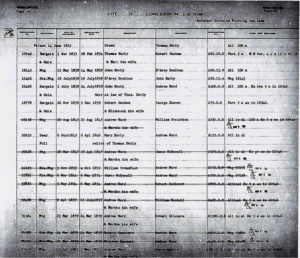
The Registry system operated on the principle of “first in time, first in right,” meaning that the order in which documents were registered determined their priority. This system required extensive title searches to establish a property’s ownership history and any encumbrances, as each transaction built upon previous ones in a continuous chain of title. Lawyers or title searchers would need to examine all recorded documents affecting a property, sometimes going back decades or even centuries, to ensure the validity of a title. If those lawyers or researchers made a mistake, the remedy for the buyer would be to sue for negligence to recover any losses.
While the Registry system provided a public record of land transactions, it had several significant drawbacks. The system did not guarantee the accuracy or completeness of the recorded information, leaving room for errors, omissions, or fraudulent entries. Additionally, as properties changed hands over time, the chain of title became increasingly complex and time-consuming to search. This complexity often led to uncertainties in land ownership and increased the risk of title defects.
As a result, many Canadian provinces began to transition away from the Registry system in favour of what is known as the Torrens system of land registration.
Land Title System (the Torrens System)
The Torrens system (also known as the Land Title system) represented a significant advancement in the tracking and registration of real property interests. The system is named after its creator, Sir Robert Torrens:

Sir Robert Torrens emigrated to South Australia from England in 1840. He quickly realized there were rampant issues with the registry-style system for tracking property interests, including errors and fraud. He sought to evolve the system to be closer to how ships were registered, which had a clear system for recording ownership and charges against them. Torrens believed that land could be registered in a similar manner.
In 1858, South Australia formally adopted the various changes proposed by Torrens and was the first jurisdiction to use the Torrens-style system for land.
The Torrens system operates on the principle of “title by registration,” where the act of registration itself creates or transfers title to land. This is in contrast to the older registry systems where registration merely recorded the existence of title documents.
Owners in a Torrens system benefit from the principle of indefeasibility of title. Once the title has been registered, a certificate of title is issued:
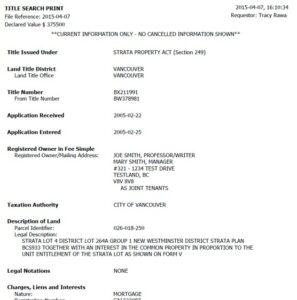
This certificate of title is guaranteed by the government to be accurate and complete. This governmental guarantee provides a high degree of certainty and security to property owners and potential buyers that the owner is, in fact, the owner. If an error occurs in the register resulting in some form of loss, the affected party can seek compensation from a government-administered assurance fund rather than having to pursue a negligence claim against the lawyers or title searchers.
British Columbia adopted the Torrens system in 1870, making it one of the earliest adopters in Canada. That adoption significantly modernized and streamlined the BC’s approach to land registration. Over time, there has developed a sophisticated online system managed by the Land Title & Survey Authority and regulated by the Land Title Act, RSBC 1996, c. 250. The electronic land title system now allows for searches of BC property and for the registration of interests against them.
External Resource
Individuals can register for an LTSA explorer account and conduct property searches for a fee:
https://apps.ltsa.ca/iam/signup

